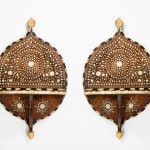Pair of Ebony and Bone-Inlaid Rosewood Turban Stands
51.5 x 31 x 14.5 cm
Further images
Decorative shelves, used for storing and displaying a turban when it is not being worn. Made from rosewood and inlaid with bone and ebony. The bone is inlaid into floral designs – a combination of flowers and leaves – set within bone and ebony geometric borders.
The top half of the backplate, above the shelf, has a central section, centred around a flower, surrounded by leaves, framed within a double border of quatrefoils. This is surrounded by foliate designs inlaid with bone, which are framed by two borders of single quatrefoils below and to the upper sides. With applied shaped bone edging decorating the mount used to support the shelf. The inlaid foliate designs continue on the lower backplate, where the designs are less dense.
The upper and lower edges of the backplate have a chevron border consisting of alternating ebony and bone, the shelf with a similar chevron moulding consisting of alternating ebony and bone, and, below this, a row of ivory finished with jagged edges. The chevron borders are secured with pegs. Two marquise-shaped finials, one at the top and one at the bottom of the backplate, are decorated with bone.
Amin Jaffer explains that inlay work was much practised throughout the Punjab, but with varying degrees of success, and that the finest inlayers were concentrated in the Hoshiarpur District. These Hoshiarpur inlaid designs were Islamic in character, hence figures played little or no role in the ornament, which was instead characterised by geometric motifs and geometrically positioned foliage, as in this example. Further evidence that these turban stands were made in the Hoshiarpur District is indicated by the use of quatrefoils and diaper ornament, which were common in the Hoshiarpur geometric borders. (Amin Jaffer, ‘Furniture from British India and Ceylon: A Catalogue of the Collections in the Victoria and Albert Museum and the Peabody Essex Museum’ (Timeless Books, New Delhi, 2001), pp. 285-7).
Hoshiarpur inlay work was usually executed on dalbergia sissoo or Indian Rosewood, which is also known as shisham. Shisham is the state tree of the Punjab and is indigenous to the region, so the shisham used to make this turban stand was grown locally. The ebony would have been brought in from the region north of Hoshiarpur, near the River Ravi. Ivory was imported from Amritsar and Jalandhar by local ivory bangle- and comb-makers, and inlayers purchased the remnants for their work. The design of this turban stand resembles that of an Ottoman or Turkish turban stand, known as a ‘Kavukluk’.








